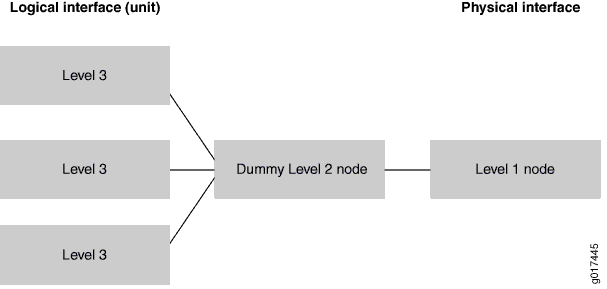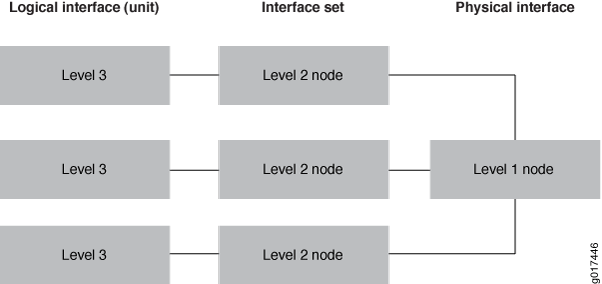Per-Unit Scheduling and Hierarchical Scheduling for MPC Interfaces
Scheduling Models Supported for MPC Interfaces
Interfaces hosted on Modular Port Concentrator (MPC) line cards in MX Series 5G Universal Routing Platforms support the following models of class-of-service (CoS) scheduling, depending on MPC type:
Limited Scale Per-Unit Scheduling MPCs
Per-unit scheduling features on a limited scale are supported for interfaces hosted on some MPCs that do not have a dedicated queuing chip.
On MPCs that support per-unit scheduling, the following scheduling capabilities are available:
-
Four or eight egress queues per unit.
-
Delay buffer capacities of 100 ms by default, and up to 200 ms maximum delay.
-
Rate shaping of the ports and their queues.
-
Guaranteed rate enforced at the queues.
The per-unit scheduling features also support pre-classification of incoming packets to protect high priority packets in the event of congestion. Such features include ingress DSCP rewrite and per-VLAN classification, ingress and egress policing, and rewrites.
Hierarchical Scheduling MPCs
MPCs that provide a dedicated queuing chip support hierarchical scheduling.
Hierarchical scheduling MPCs support all per-unit scheduling functionality plus fine-grained queuing abilities over four or five levels of hierarchical scheduling:
-
Hierarchical scheduling with ports, interface sets, and logical interfaces.
-
Shaping—Committed Information Rate (CIR) and a peak information rate (PIR)—at all scheduling levels, including queues.
-
Three normal- priority levels and two excess- priority levels configurable at all scheduling levels, including queues.
-
Per-priority shaping of traffic at Level 1 or Level 2.
-
Shaping for unconfigured customer VLANs (C-VLANs) and for service VLANs (S-VLANs).
Scheduler Node Levels for MPC Interfaces
Interfaces hosted on MPCs support different scheduler node levels, depending on the MPC type:
- Scheduler Node Levels for Per-Unit Scheduling MPCs
- Scheduler Node Levels for Hierarchical Scheduling MPCs
Scheduler Node Levels for Per-Unit Scheduling MPCs
For an interface hosted on a per-unit scheduling MPC, each logical interface has its own dedicated level 3 node, and all logical interfaces share a common level 2 node (one per port).
Figure 1 illustrates scheduler node levels for an interface hosted on a per-unit queuing MPC.

For interfaces hosted on per-unit scheduling MPCs, the level 2 node is always a dummy node.
Scheduler Node Levels for Hierarchical Scheduling MPCs
The queuing model used by interfaces hosted on hierarchical scheduling MPCs supports up to five levels of scheduler nodes: the queue itself (level 5), session logical interface (ppp or dhcp) (level 4), customer VLAN (C-VLAN) (level 3), the interface set or service VLAN (S-VLAN) collection (level 2), and the physical interface or port (level 1).
Figure 2 illustrates the scheduler node levels for an interface hosted on a hierarchical scheduling MIC or MPC.

The figure depicts scheduler nodes for an interface that does not include interface sets and for which traffic control profiles are applied to the logical interfaces only.
If an interface set has a CoS scheduling policy but none of its child logical interfaces has a CoS scheduling policy, then the interface set is considered to be a leaf node and has one level 2 and one level 3 node.
